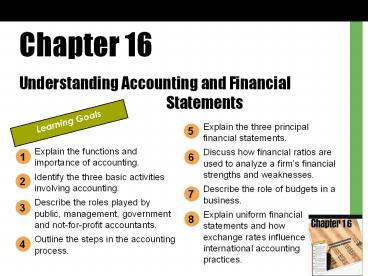Understanding Accounting and Financial Statements - PowerPoint PPT Presentation
1 / 15
Title:
Understanding Accounting and Financial Statements
Description:
Chapter 16 Understanding Accounting and Financial Statements Learning Goals Explain the three principal financial statements. Discuss how financial ratios are used to ... – PowerPoint PPT presentation
Number of Views:289
Avg rating:3.0/5.0
Title: Understanding Accounting and Financial Statements
1
Chapter 16 Understanding Accounting and Financial
Statements
Learning Goals
Explain the three principal financial
statements. Discuss how financial ratios are used
to analyze a firms financial strengths and
weaknesses. Describe the role of budgets in a
business. Explain uniform financial statements
and how exchange rates influence international
accounting practices.
5
Explain the functions and importance of
accounting. Identify the three basic activities
involving accounting. Describe the roles played
by public, management, government and
not-for-profit accountants. Outline the steps in
the accounting process.
1
6
2
7
3
8
4
2
Accounting Process of measuring, interpreting,
and communicating financial information to
support internal and external business decision
making. USERS OF ACCOUNTING INFORMATION
3
BUSINESS ACTIVITIES INVOLVING ACCOUNTING
Accounting plays a key role in each of a
businesses three key areas Financing
activities Provide necessary funds to start and
expand a business. Investing activities
Provide valuable assets required to run a
business. Operating activities Focus on
selling goods and services, but they also
consider expenses as important elements of sound
financial management.
4
ACCOUNTING PROFESSIONALS Public
Accountants Public accountant Accountant who
works for an independent accounting
firm. Certified public accountant (CPA)
Accountant who meets specified educational and
experiential requirements and has passed a
comprehensive examination on accounting theory
and practice. Management Accountants Management
accountant Accountant employed by a business
other than a public accounting firm. Government
and Not-for-Profit Accountants Perform
professional services similar to those of
management accountants.
5
THE ACCOUNTING PROCESS Accounting process Set of
activities involved in converting information
about transactions into financial statements.
6
The Impact of Computers and the Internet on the
Accounting Process Simplifies the accounting
process by automating data entry and
calculations. Software that handles accounting
information for international businesses is also
available. The Foundation of the Accounting
System Generally accepted accounting principles
(GAAP) Principles that encompass the conventions,
rules, and procedures for determining acceptable
accounting practices at a particular time.
Financial Accounting Standards Board (FASB)
Organization primarily responsible for
evaluating, setting, or modifying GAAP in the
U.S. Sarbanes-Oxley Act A response to cases of
accounting fraud. Created the Public
Accounting Oversight Board. Added to the
reporting requirements for publicly traded
companies.
7
The Accounting Equation Assets Anything of value
owned or leased by a business. Tangible
Equipment, buildings, inventory. Intangible
Patents, trademarks Liability Claim against a
firms assets by a creditor. Owners equity All
claims of the proprietor, partners, or
stockholders against the assets of a firm, equal
to the excess of assets over liabilities. Basic
accounting equation Relationship that states that
assets equal liabilities plus owners
equity. Double-entry bookkeeping Process by
which accounting transactions are entered each
individual transaction always has an offsetting
transaction.
8
FINANCIAL STATEMENTS Provide managers with
information for evaluating organizations ability
to meet current obligations and needs, its
profitability, and its overall financial
health. The Balance Sheet Balance sheet Statement
of a firms financial positionwhat it owns and
the claims against its assetsat a particular
point in time.
9
(No Transcript)
10
The Income Statement Income statement Financial
record of a companys revenues, expenses, and
profits over a period of time. Helps decision
makers focus on overall revenues and the costs
involved in generating these revenues. Sometimes
called a profit-and-loss, or PL, statement.
11
(No Transcript)
12
The Statement of Cash Flows Statement of cash
flows Statement of a firms cash receipts and
cash payments that presents information on its
sources and uses of cash. Accrual accounting
Accounting method that records revenue and
expenses when they occur, not necessarily when
cash actually changes hands. Inadequate cash
flow is a reason for many business failures.
13
(No Transcript)
14
FINANCIAL RATIO ANALYSIS Ratio analysis Tool
for measuring a firms liquidity, profitability,
and reliance on debt financing, as well as the
effectiveness of managements resource
utilization.
15
BUDGETS Budget Planning and control tool that
reflects a firms expected sales revenues,
operating expenses, and cash receipts and
outlays. Cash budget Tracks the firms cash
inflows and outflows.































